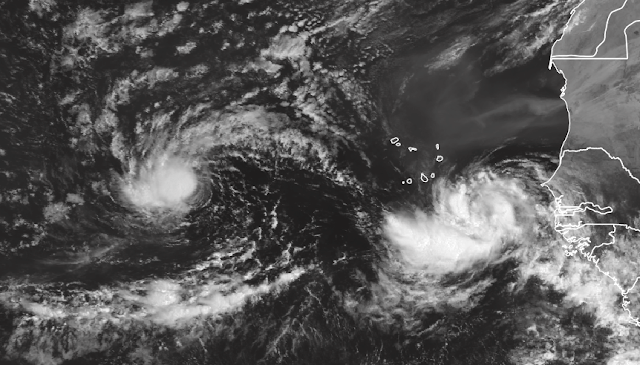This week is the climatological peak of hurricane season, and it's certainly living up to that expectation. There are three active hurricanes: Florence, Helene, and Isaac, as well as two areas of concern for future development.
The last time we saw three simultaneous hurricanes was in 2017, and there were actually *four* simultaneous hurricanes in 1998. So this is active, but far from unprecedented. Now on to business...
For the first time since Thursday, Florence is a major hurricane (Category 3+) with 115 mph sustained winds. The appearance on satellite is spectacular, indicating that it is now in an ideal environment for rapid intensification. This was expected, but certainly not good news for the southeast and mid-Atlantic U.S. coast. The atmosphere and ocean ahead of it can easily support a Category 4 or 5 hurricane.
This is an extremely dangerous situation for the Carolinas.
In fact, this is shaping up to be a historic event. The
official forecast from NHC has Florence making landfall between Charleston SC and Norfolk VA with 66% probability (the definition of the cone of uncertainty) as an upper-end Category 4 hurricane. Tropical storm force winds should arrive as early as Wednesday evening, while storm surge and rainfall will be joining the winds between Wednesday afternoon and Thursday morning. It's too early to have a sense of maximum storm surge placement since it is so sensitive to the track. However,
storm surge and coastal flooding will almost certainly be a big problem from North Carolina up into the Long Island area, including the Delmarva peninsula and New Jersey through the weekend.
Since 1851, the continental U.S. has only experienced 29 direct landfalls from Category 4 and 5 hurricanes, and the northernmost was on the SC/NC border (Hazel in 1954). See
https://twitter.com/BMcNoldy/status/1038903174172688389 for a map. North Carolina has never experienced a Category 4 or 5 hurricane landfall, and only three Category 3 landfalls on record. Events such as this are infrequent -- testing people, structures, vegetation, resources, and plans.
Ensemble guidance from the U.S. and European models still have some spread, ranging from a landfall in northern Florida to recurving just before reaching the coast. Unfortunately, this is how predicting the future works... best expressed as probabilities rather than certainties. As the saying goes: prepare for the worst and hope for the best.
Another aspect of the forecast is what happens to Florence after landfall? Does it keep moving inland and dissipate while spreading rain over a larger area, or does it stall for several days and unleash rain measured in feet. As of now, most models suggest the latter... a stalled tropical cyclone producing incredible and dangerous amounts of rain over the mid-Atlantic region.
 |
| Seven-day rainfall forecast, valid from Monday morning through next Monday morning... and it could still be raining beyond this in the same areas. (NOAA/WPC) |
Further east, Helene became the season's 4th hurricane on Sunday afternoon, and Isaac became the season's 5th hurricane on Sunday night. Climatologically, the 5th hurricane forms on October 6th, so this is ahead of par.
It appears very likely that
Helene will maintain hurricane status for another three days or so, but make a sharp turn to the north over cold water and dissipate quickly in the middle of the Atlantic.
Isaac is a growing concern for the storm-ravaged Lesser Antilles. Although its a bit disorganized now, the forecast is for it to continue westward as a hurricane, reaching the islands on Thursday. It does not appear that it will be too strong though, as wind shear should start affecting it by Wednesday. Nothing like Maria last September.
In terms of ACE (Accumulated Cyclone Energy), the season was above average up until August 21 when it finally slipped below average. As of this morning, it is at 89% of average for the date. Remember that it takes a lot of action this time of year to keep up with climatology! Unfortunately, some of that action can occur near land.
The other two areas of interest are located in the western Caribbean and over the north-central Atlantic. The disturbance in the western Caribbean is expected to drift through the Gulf of Mexico from Wednesday through Friday, eventually bringing rain to Texas... but models generally do not indicate significant strengthening -- maybe a tropical storm. The north-central Atlantic system is a non-tropical low that could gradually acquire subtropical or even tropical characteristics, but also does not appear to be anything to watch too closely (it could actually interact with and get absorbed by Helene!).











